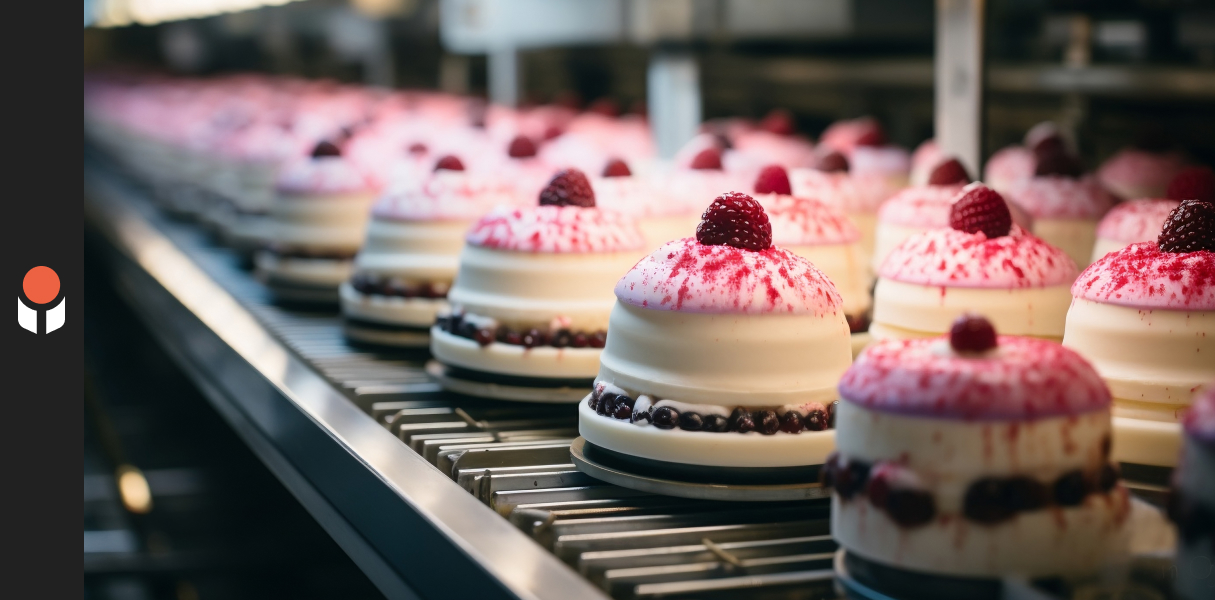A Robotic Retrofit Case Study
Upgrading existing machinery in a robotic retrofit to increase accuracy and quality
Rise Baking Company outside Atlanta makes and decorates cakes that it sells to large supermarket chains. Responding to these retailers’ requests for more intricate decoration on the cakes usually required handwork. The company was also getting complaints about the quality of some decorations. They called on Concept Systems to solve these problems while retaining their existing robots, leading to a robotic retrofit.
The Problem: One-Size-Fits-All Approach Isn’t Effective
Rise Baking Company’s cake-decorating operation used robots to apply decorative frosting, such as dollops or borders. The robot determined where to put the frosting based on a 2-D image of each cake. The robots had to simply assume the cake was whatever height the operator specified. But the true height of each cake varies. If it’s off by as little as an eighth of an inch, decorations could be distorted. They were getting some complaints from customers, and it was only able to do some requested decorations manually.
But every cake is different
A 2-D vision system cannot accurately tell the robots the height of the cake. The robots had to simply assume the cake was some specified pre-programmed height. But cakes don’t come out the same every time. The true height of each varies. Variance of as little as an eighth of an inch would cause distortion in the carrot shape, for instance. In fact, customers were complaining that the carrot shapes often looked wrong.
One customer also was asking for borders or dollops around the bottom edge of the cake, but the 2-D image didn’t provide accurate data about the exact shape and diameter around the bottom of the cake. Rarely is it precisely the same as the top.
The company’s solution was to do the bottom borders by hand — a significant investment of time and labor.
Difficulty Adding New Cake Designs
If Rise Baking Company wanted to add new cake designs, the process was quite difficult and involved very specialized expertise that the plant didn’t have available onsite. A new program had to be created within the 2D vision system and robot controller for each new cake design. This required someone with experience programming robots, and sometimes it was necessary to create the program from scratch. Due to these complexities, the company rarely added new cake designs to the system.
Changeover delays
Another problem had to do with constraints of the 2-D camera, which took a photograph in poor lighting. When the plant switched from vanilla to chocolate cake, the camera needed to be adjusted to account for changes in contrast. To ensure accurate images, operators had to adjust the lighting, do some calibration, take a sample image and modify the settings until things were looking good.
Along with vision system optimization, the operator or a maintenance person had to also change the program in the robot through a separate controller and interface. Throughout this time, the line was effectively down.
The Solution: A Robotic Retrofit
Concept Systems retrofitted the existing Fanuc Robots with Hermary SL1880 3-D scanners that use laser triangulation to create a three-dimensional image of each individual cake. So the robots now know not only the actual height of each cake but also the nuances of shape. Concept Systems reprogrammed the robots to use this new information. Additionally, new touch screen user interfaces are easier to use and reduced training time.
Going 3-D
The existing robots in the plant were fine, so Concept Systems came up with a plan to retrofit them with a more advanced vision system that could know what the cake looked like in three dimensions. In order to accomplish this, Concept created a new program that used the vision data as offsets.
This setup simplified the entire system, as everything could be done through a single, friendlier user interface. As opposed to modifying the vision system and robot controller each time cake designs changed, the operators could now use a single operator interface to alert the system that something different was running.
Two Hermary SL1880 3-D laser scanners were installed on each line. Rather than taking a photographic image like the old system, they use laser triangulation to create what’s called a “point cloud,” showing the precise shape of the cake, including its exact height every five degrees around its circumference.
This three-dimensional image of each individual cake is passed to the robots so they can adjust not only to the actual height but also the nuances of shape within each cake.
The Results
In the end, Rise Baking Company was able to create higher quality and more intricate frosting designs using the robots. A good deal of manual work was eliminated — for instance the application of a bottom border of frosting.
Also, the new user interface allows much faster and easier adjustment of designs. A new cake design could be implemented through the friendly operator interface, rather than requiring a skilled programmer of both vision systems and the robot. And finally, the color of the cake does not interfere with the lasers, so changeover time lost to calibrating the vision system was eliminated.
“We came in far under budget because the system was so easy to operate. Our training costs were far less than expected. While on site, Concept Systems also reviewed other parts of our project and gave solid advice in areas where they were not specifically looking for additional work — this really proved they are in business for the best interest of their customers.”
– Factory Manager
The Project Details
ROI
8 Months
Project Duration
5 Months
Team
Client: 1 engineer, 1 plant manager
Concept Systems: 1 engineer
Technology Used
Hermary SL1880 3-D scanners
Fanuc robots (already in the plant)

